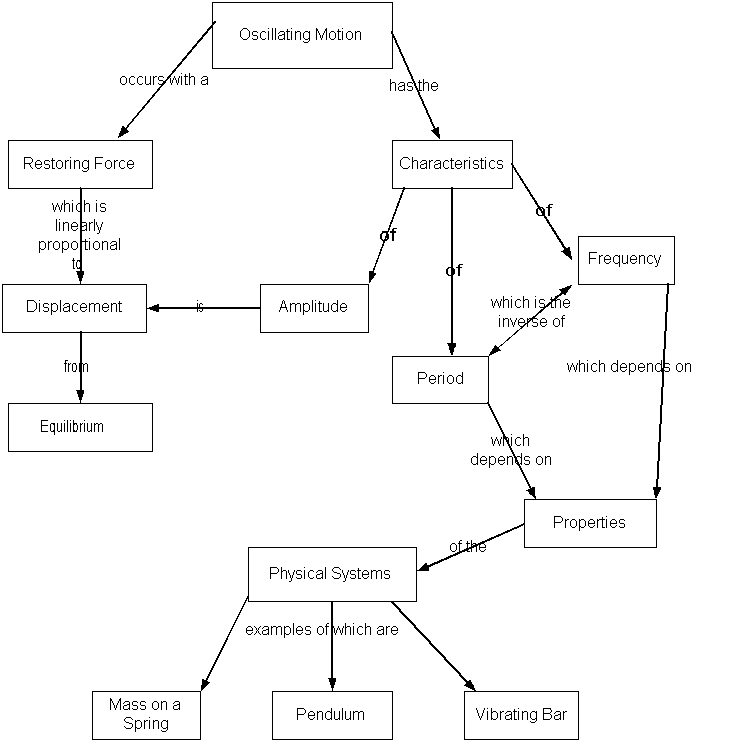- Evaluate student presentation of their findings and how they support them, as well their participation in the discussion.
- Have students build a concept map after the discussion of the exploration activity. A second map will be built after completion of the unit and a comparison made to determine any changes in student conceptions. Possible concepts to be included in the map are: restoring force, oscillation, simple harmonic motion, period, frequency, amplitude, mass, acceleration, position, velocity and equilibrium. One possible "expert" map is included below as an example.In concept mapping there is NO one right answer.

If the map is not clear, open the image in a new window.
- During both labs, evaluate students experimental techniques and use of the equipment through observation
- Following the first lab - lab results and write-up
- Evaluate the experimental design proposed for the second lab
- Following the second lab - mathematical analysis of the data, graph if they produce one and their conclusions.
- As mentioned in the directions, teachers could assess studentsí scientific investigation skills. This would be done by not telling them how to collect data but rather assessing whether they collected enough data points, whether they only changed one variable at a time and whether their choice of experimental values to test were reasonable in size and sufficient in range. A student with good experimental skills would investigate the effect of mass on period by using one spring constant close in value to their experimental value, test at least 7 different masses, and use values for the mass which were reasonable (e.g. near the range of masses they used to determine the spring constant.) Certainly the largest mass they test should only be 1-2 kg. Then the student would repeat keeping the mass the same and varying the spring constant. Again they should collect at least 7 data points and spring constants should vary between 1/10 and 10 times their experimental value.
- Evaluate the studentsí written summary of their results. A very nice rubric for evaluating written responses has been developed by the state of Maryland.
- Evaluate the studentsí graphical analysis of their results. A very nice graph rubric has been developed by the State of Maryland.
- Evaluate student conception of the how acceleration, velocity and position vary. Specifically pay attention to those possible misconceptions about direction of velocity and acceleration as described in the Preconceptions section. This would be an excellent place to use Peer Instruction Techniques as outlined in the Teaching Tips section.
- Teachers who plan on having students build several models may want to have the students keep a log of the common traits and differences between the models.
- Assess the quality of the data and documentation sent to the math students.
- Assess each additional lab performed and/or model built or used in similar fashion to those above. Some models may be pre-built for use by the students, so the assessment would be limited to the appropriateness of their manipulation.
- Assess the final concept map and self-evaluation. Student concept maps should show some advancement in their understanding of oscillating motion and how the different physical systems are similar.
- Have students complete a concept test which specifically is designed to check for understanding and whether student preconceptions about position, force, velocity and acceleration in oscillatory motion have changed.